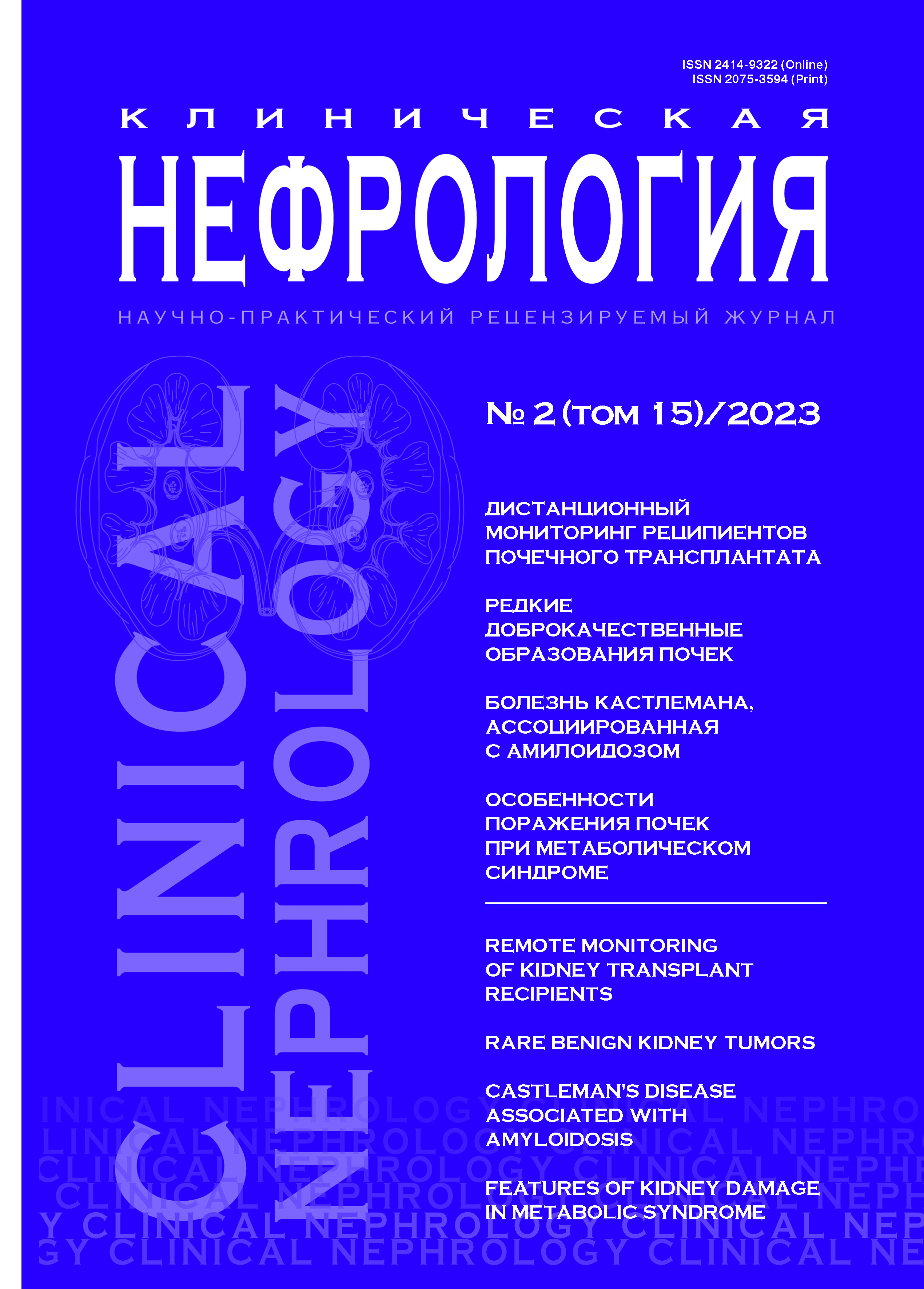Intraoperative ultrasound navigation in minimally invasive organ-preserving treatment of renal cell carcinoma of a transplanted kidney
- Авторлар: Trushkin R.N.1, Isaev T.K.1, Medvedev P.E.1, Sokolov S.A.1, Morozov N.V.1, Parshin V.V.1, Son A.A.1, Klementyeva T.M.1
-
Мекемелер:
- City Clinical Hospital № 52 of the Moscow Healthcare Department, Department of Urology
- Шығарылым: Том 15, № 2 (2023)
- Беттер: 26-30
- Бөлім: Nephrourology
- URL: https://journals.eco-vector.com/2075-3594/article/view/551810
- DOI: https://doi.org/10.18565/nephrology.2023.2.26-30
- ID: 551810
Дәйексөз келтіру
Аннотация
Background. Organ-preserving minimally invasive techniques in the treatment of renal parenchymal cancer have now taken a leading position in modern oncology. Intraoperative ultrasound provides navigation in case of intraparenchymal formations of the renal parenchyma of small size. The use of this technique for laparoscopic resection of one's own kidneys is widespread; to date, however, there are no data on the use of intraoperative ultrasound for resection of a kidney graft with a tumor in the world. It should be noted that more than 1,500 kidney transplantations are performed annually in the Russian Federation and the incidence of renal cell carcinoma (RCC) of a transplanted kidney is about 0.5%. Kidney transplant patients have two-fold risk of developing neoplasms compared to the general population, and despite the low incidence in this group, such patients require a non-standard approach from clinicians and represent a difficult clinical case.
Objective. Evaluation of the possibility of using intraoperative ultrasound diagnostics in laparoscopic resection of a kidney graft with a tumor.
Material and methods. 22 patients underwent laparoscopic resection of a transplanted kidney with a tumor at the City Clinical Hospital № 52 from 2016 to 2022. 15 lesions were determined intraparenchymally and were detected only with intraoperative ultrasound.
Results. All patients underwent laparoscopic resection of a transplanted kidney with a tumor using intraoperative ultrasound navigation. There was no bleeding or death.
Conclusion. Intraoperative ultrasound navigation made it possible to identify and visualize intraparenchymal renal graft formations during laparoscopic resection of a transplanted kidney with a tumor. The use of this instrumental diagnostic method in the era of nephron-sparing treatment methods is certainly justified and makes it possible to reduce the volume and duration of the surgery.
Толық мәтін
Авторлар туралы
Ruslan Trushkin
City Clinical Hospital № 52 of the Moscow Healthcare Department, Department of Urology
Хат алмасуға жауапты Автор.
Email: uro52@mail.ru
ORCID iD: 0000-0002-3108-0539
Dr.Sci. (Med.), Head of the Department of Urology, City Clinical Hospital № 52 of the Moscow Healthcare Department
Ресей, MoscowTeimur Isaev
City Clinical Hospital № 52 of the Moscow Healthcare Department, Department of Urology
Email: dr.isaev@mail.ru
ORCID iD: 0000-0003-3462-8616
Cand. Sci. (Med.), Urologist at the Department of Urology, City Clinical Hospital № 52 of the Moscow Healthcare Department
Ресей, MoscowPavel Medvedev
City Clinical Hospital № 52 of the Moscow Healthcare Department, Department of Urology
Email: pah95@mail.ru
ORCID iD: 0000-0003-4250-0815
Urologist at the Department of Urology, City Clinical Hospital № 52 of the Moscow Healthcare Department
Ресей, MoscowSergey Sokolov
City Clinical Hospital № 52 of the Moscow Healthcare Department, Department of Urology
Email: sergey.sokolow@mail.ru
ORCID iD: 0009-0004-7016-2360
Urologist at the Department of Urology, City Clinical Hospital № 52 of the Moscow Healthcare Department
Ресей, MoscowNikolay Morozov
City Clinical Hospital № 52 of the Moscow Healthcare Department, Department of Urology
Email: nikmorozov@rambler.ru
Urologist at the Department of Urology, City Clinical Hospital № 52 of the Moscow Healthcare Department
Ресей, MoscowVasily Parshin
City Clinical Hospital № 52 of the Moscow Healthcare Department, Department of Urology
Email: vasilii_parshin@mail.ru
ORCID iD: 0000-0003-3783-3412
Head of the Radiology Department, City Clinical Hospital № 52 of the Moscow Healthcare Department
Ресей, MoscowAleksey Son
City Clinical Hospital № 52 of the Moscow Healthcare Department, Department of Urology
Email: alalson@mail.ru
Anesthesiologist, City Clinical Hospital № 52 of the Moscow Healthcare Department
Ресей, MoscowTamara Klementyeva
City Clinical Hospital № 52 of the Moscow Healthcare Department, Department of Urology
Email: uro52@mail.ru
Nephrologist, City Clinical Hospital № 52 of the Moscow Healthcare Department
Ресей, MoscowӘдебиет тізімі
- Kaprin A.D., V.V. Starinsky V.V., Shakhzadova A.O. The state of oncological care to the population of Russia in 2021, Moscow, 2022. Fig. 239 p. [Каприн А.Д., В.В. Старинский В.В., Шахзадова А.О. Состояние онкологической помощи населению России в 2021 г. М., 2022. Илл. 239 с. (In Russ.)].
- Favi E., Raison N., Ambrogi F., et al. Systematic review of ablative therapy for the treatment of renal allograft neoplasms. W. J. Clin. Cases. 2019;7(17):2487–504. doi: 10.12998/wjcc.v7.i17.2487.
- Motta G., Ferraresso M., Lamperti L., et al. Treatment options for localised renal cell carcinoma of the transplanted kidney. W. J. Transplant. 2020;10(6):147–61. doi: 10.5500/wjt.v10.i6.147.
- Griffith J.J., Amin K.A., Waingankar N., et al. Solid Renal Masses in Transplanted Allograft Kidneys: A Closer Look at the Epidemiology and Management. Am. J. Transplant. 2017;17:2775–81.
- Tillou X., Guleryuz K., Collon S., Doerfler A. Renal cell carcinoma in functional renal graft: Toward ablative treatments. Transplant. Rev. (Orlando). 2016;30:20–26.
- Gu L., Liu K., Shen D., et al. Comparison of robot-assisted and laparoscopic partial nephrectomy for completely endophytic renal tumors: a high-volume center experience. J. Endourol. 2020;34(5):581–87.
- Li M., Cheng L., Zhang H., et al. Laparoscopic and Robotic-Assisted Partial Nephrectomy: An Overview of Hot Issues. Urol. Int. 2020;104(9–10):669–77. doi: 10.1159/000508519.
- Qin B., Hu H., Lu Y., et al. Intraoperative ultrasonography in laparoscopic partial nephrectomy for intrarenal tumors. PLoS One. 2018;13(4):e0195911. doi: 10.1371/journal.pone.0195911.
Қосымша файлдар











